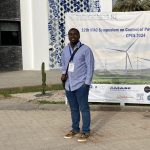Ineza Remy Mugenga, Abebe Geletu, Pu Li: Chance Constrained Distributed Optimisation for Interconnected Power Systems. In: 12th IFAC Symposium on Control of Power & Energy Systems (CPES) (July 2024). https://doi.org/10.1016/j.ifacol.2024.07.471
Abstract: Microgrids have been attracted increasingly attention due to renewable energy integration. Multiple microgrids are often interconnected for benefiting each other. A significant challenge in operating such power systems lies in the uncertainties including intermittence in renewable energy sources and load demands estimation. Sharing state variables in interconnected systems poses additional difficulties. This paper proposes a numerical solution approach to a chance constrained distributed optimisation for interconnected power systems under uncertainty. The inner-outer approximation approach is used for the solution and ALADIN for numerical implementation. An interconnected optimal power flow problem with a three-bus and a four-bus system is solved as a case study.
Marcy Audrey Demafo Nangmo, Abebe Geletu and Pu Li: Development of Sustainable Food Storage Systems: Mathematical Modelling and Analysis
Abstract: Food insecurity and high food prices in the market are among the impending challenges facing the world today. Currently, a third of the world’s annual food production is either wasted or lost. In fact, inadequate storage conditions for agricultural products, particularly prevalent in sub-Saharan Africa, contribute significantly to this loss and exacerbate post-harvest challenges. Additionally, low-income farmers‘ reliance on old-fashioned food storage systems has led to an increase in food losses, resulting in reduced income from their products. The aim of this work is to study and develop an efficient and sustainable food storage system that enables longer shelf-life of fresh agricultural products, thereby reducing food loss and increasing farmers‘ profitability. A food storage system includes various components that involve multiple interactions. The work develops a mathematical model of such a system that describes physical processes, including the dynamics of the biological process of stored food and interactions with the environment. The developed mathematical model consists of coupled partial and ordinary differential equations. Thermal analysis is also performed based on the operating conditions that affect the dynamics of the system. Preliminary results illustrate the positive influence of the initial product temperature on the thermal behavior of a loaded food warehouse and the impact on the required cooling capacity. Examining the initial temperatures of various products highlights the importance of the pre-cooling phase before storage. Further simulations and analyzes of the influence of other operating conditions, including device dimensions and environmental conditions, are currently being investigated.
Peguy Kameni Nteutse and Abebe Geletu: Investigation of Knee Torque Dynamics in Single-Leg Transfemoral Prosthetic during Walking using Mathematical Modeling. In: International African Conference on Machine Learning, Optimization, and Applications (MLOA) (July 2023)
Abstract: Transfemoral amputees rely on prosthetic devices to restore their mobility and maintain their independence. However, the design and performance of these devices can significantly affect the amputee’s gait and overall functionality. In this study, we investigate the knee torque dynamics of a single-leg transfemoral prosthetic during walking using a mathematical model that takes into consideration knee friction force (β2), the horizontal component of the ground reaction force (F1), and the vertical component of the ground reaction force (F2). By carrying out model simulation in MATLAB tool, along with Simulink, we derived the tracking error between the generated knee torque of the transfemoral prosthesis and the knee torque trajectory for a normal human leg. This error was evaluated using the normalized root mean square error (NRMSE) method. Our results show that when β2 = 0.3 N.s.m−1, F1 = 320 N , and F2 = 800 N , a tracking error of NRMSE = 0.342868% occurs. A comparison between the simulated knee torque and a desired knee torque trajectory for a normal leg study in the literature suggests that the tracking error generated will force the amputee to use higher metabolic energy to minimize discomfort while walking. These findings highlight the importance of optimizing the design and performance of transfemoral prosthetic devices to improve the knee torque dynamics and overall functionality of amputees. Our mathematical model provides a useful tool for future research in this field, which could help develop more effective prosthetic devices for transfemoral amputees.


